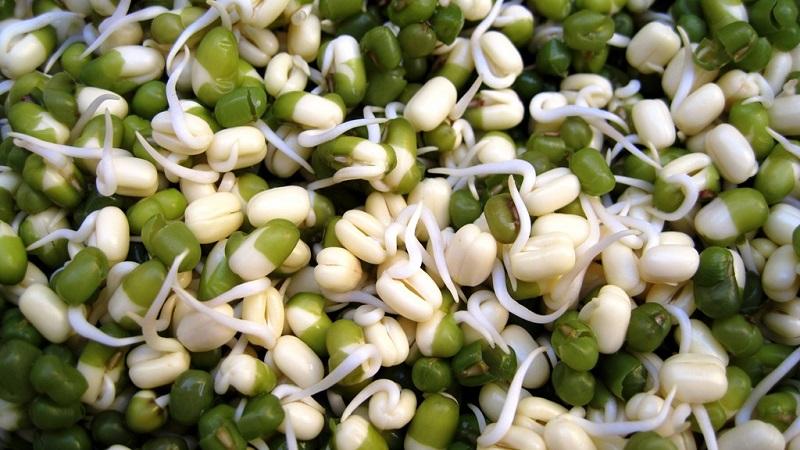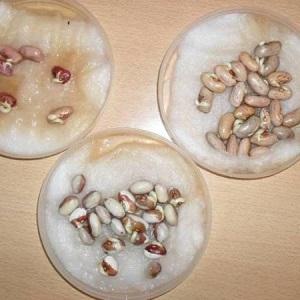We get a storehouse of vitamins from a bean - how to sprout beans at home or grow them in the open field
In terms of protein content, beans rank second after meat. It is rich in fiber, pectin, carbohydrates and fats, it contains vitamins A, C, PP and B group, micro and macro elements such as iron, fluorine, zinc, phosphorus, iodine, copper, potassium, calcium, magnesium, flavonoids etc.
Bean sprouting is popular with healthy people. Their sprouts are one of the staples on the raw, vegan, and vegetarian diet. In this article, we will tell you in detail how to sprout beans and what are the benefits of this product.
The content of the article
Why sprout beans
Sprouted beans are biogenic and healthy due to the absence of enzyme inhibitors, aflatoxin and phytic acid. Enzymes break down proteins, fats and carbohydrates, making them easier for the body to absorb.

Attention! The benefits of sprouts in comparison with grains are several times higher.
Useful characteristics
Seedlings promote cell regeneration, increase immunity, block inflammatory processes.
The use of bean sprouts is recommended when cardiovascular diseases, during diets aimed at restoring salt balance. Thanks to arginine, it is used to lower blood sugar.
Also it has a beneficial effect on digestion, hematopoiesis processes, stimulates removing toxins from the body, improves the condition of the skin, nails, hair and teeth.
Contraindications to use
Choose Beans Carefully for Raw Eating... Some of them contain poisonous substances that cause food poisoning and decompose only during heat treatment.
Safe:
- adzuki beans;
- black beans;
- mung beans;
- pinto beans.
Experts recommend that sprouts purchased in stores or on the market be heat treated... The warm and humid environment in which the grains are germinated is favorable for the growth of bacteria.
Want to eat sprouts raw and not worry about your health - Learn how to sprout beans yourself.
How sprouted beans are used on the farm
Gardeners sprout beans before planting in the ground to speed up sprouting... Let's take a closer look at how this is done.
Basic ways
 Seeds intended for sowing can be treated with chemicals... Before germinating them for culinary purposes, find out if they are suitable for food - read the instructions.
Seeds intended for sowing can be treated with chemicals... Before germinating them for culinary purposes, find out if they are suitable for food - read the instructions.
How to sprout beans at home:
- sort out, throw away dried, rotten and spoiled grains;
- rinse several times with running water;
- Fill the container chosen for soaking with beans by a third;
- pour water about 2-3 cm above the grain level;
- put away in a warm place where direct sunlight does not fall;
- after 8-10 hours, drain the water, rinse the swollen grains thoroughly;
- pour the soaked grains into a flat container on a napkin and cover with another napkin;
- pour plenty of warm water;
- make sure that the surface does not dry out;
- after a few hours, sprouts will appear on the grains.
When sprouting beans for seedlings, sawdust or cotton wool is used instead of a napkin, for food intended for food, water and a napkin are regularly changed.
The germination rate depends on the variety - on average 4-5 days, but many raw foodists eat them on the second day.
Read more:
How to eat sprouted beans
Sprouts are eaten fresh, stored in the refrigerator for no more than five days... Be sure to rinse the sprouts before eating.
Attention! For antibacterial treatment, the sprouts are briefly placed in a soda solution.
 They are used in salads, soups, as a side dish for meat and in vegetable stew.... Sprouted beans are used to prepare Georgian lobio and Mexican chili.
They are used in salads, soups, as a side dish for meat and in vegetable stew.... Sprouted beans are used to prepare Georgian lobio and Mexican chili.
The classic Chinese recipe is a dish made from sprouts., fried with garlic, ginger and green onions, with the addition of salted or smoked fish.
In Asia, red adzuki beans are used salted., as a filling for pies and pancakes, as well as for making sweet sauce.
For Koreans, sprouts are not just food, but also medicine... They are especially in demand in early spring when there is a shortage of fresh vegetables.
How to grow beans at home
Beans - a plant with a short light period no longer than 12 hours... To increase the yield, they artificially reduce the length of daylight hours, covering them with an opaque covering material.
This culture is thermophilic; in cold climates, only early maturing varieties are planted.... Or grown indoors. When the spring frosts end and the soil warms up to temperatures above 12 degrees, it is planted in open ground.
The plant needs to be watered in a timely manner, periodically weed and regularly loosen, prevent the formation of a shriveled crust on the surface of the soil, inspect for disease and pest damage.
How to choose the right variety of beans for your home
The variety is chosen depending on the climatic zone and the place of planting..
Beans are divided into curly and bush, and those, in turn, are of three types: peeling, asparagus and decorative.
The shelling is called grain... Only beans are used for food, as the pods are tough and inedible. Its varieties are thermophilic, with a long growing season, ripen in open ground only in warm climates.
Asparagus is called vegetable and leguminous... Eat green pods that are free of tough fibers. In the middle lane, early-ripening varieties begin to bear fruit about 60 days after germination, late ones - after 100 or more. The crop can be harvested all the time, until frost. Seedlings are planted to the north in open ground.
Ornamental plant for beauty and health of the soil... Like other legumes, it accumulates nitrogen in the soil, which it takes from the air. Tomatoes, potatoes and other plants love nitrogen-rich soil.
Good to know. Bean neighbors in the garden are less likely to get late blight.
Fans of growing vegetables at home plant bush varieties on the balcony or loggia - they ripen faster and have a root system of no more than 10-20 cm in depth, and stems up to 50 cm high.Such varieties do not need large pots, a lot of soil and complex structures for tying, a stick up to 60 cm high is enough.
In curly, the root reaches a length of 1 m, and the stems up to 5 m in length... Better to grow it outdoors. She not only bears fruit abundantly, but also decorates the site. It is used to braid pergolas, gazebos and fences, or build supports that can withstand strong winds.
Vertical planting of curly beans saves space in small areas. Compared to bush, it is more resistant to pests.

Preparation of planting material and land
2–3 days before planting, the soil should be dug up and loosened, and disinfect the prepared soil with a weak warm solution of potassium permanganate.
Features. Beans have an extraordinary germination capacity. An intact bean will sprout anyway.
Planted with dry, sprouted grains or seedlings, depending on how soon the seedlings are needed. Sprouted beans are laid out in the holes carefully, because they are vulnerable.
How to plant beans in a pot for seedlings
For seedlings prepare containers with a peat-humus mixture, a mixture of compost with turf soil or a mixture of garden and turf soil. It is advisable to add sand to the last two.
Further make holes 3-4 cm deep and place dry or germinated grains in them... The pots are placed in a lighted place with a temperature above 20 degrees. After 15-20 days, the seedlings are ready for planting, they are transplanted into open ground in the phase of 2-3 leaves.
How to plant and care for beans outdoors
You need to plant in a place protected from the wind... In a cold snap, early shoots should be covered with non-woven fabric. It is recommended to sprout sprouts when they reach 15 cm in height. The tops must be tied up so that they do not spread along the ground and do not cling to neighboring plants.
Features. The beans are not planted in the same place earlier than after 4 years.
Loose fertile soil is chosen for planting.... Grows well on loam, sandy loam soils, does not like swampy lowlands. The clay soil for beans is mulched with humus, mature compost and sand.
It will be interesting:
Watering beans, removing weeds and loosening the soil
Care includes removing weeds and loosening the soil... The plant does not tolerate waterlogging and needs air flow to the roots. The hardened surface of the earth must be broken up between waterings. It is more convenient to loosen it with a small tool, shallow, so as not to harm the roots.
Peeling varieties are watered as needed before flowering., alternating moisturizing with loosening. During the budding period, watering is suspended, during the formation and ripening of fruits, it is doubled, by the end of the growing season, it is gradually stopped.
Asparagus and ornamental watered moderately and regularly throughout the season.
Insufficient watering can cause flowers to fall and ovaries, as well as negatively affect the taste of the crop. Stagnant water threatens with excessive growth of the leaf mass and the risk of decay.

Potassium deficiency leads to bacterial and fungal diseases... Indicator of element deficiency: the appearance of yellow spots on leaves and pods. To avoid this, a small amount of rotted bird droppings are introduced into the beds or sprinkled with wood ash.
Features. To attract pollinating insects, beans are sprayed with sweet water.
Harvesting the first harvest
The timing of harvesting beans directly depends on its variety.
Asparagus is removed every 2-3 days throughout the growing season... If you do this less often, the pods will overripe and hinder the development of new ones. Ripe beans are considered to be poured and formed. You need to separate the pod from the stem with scissors, without disturbing the plant.
Ripening husk varieties requires patience... They are harvested gradually, removing the mature pods and leaving the green ones to ripen. You can determine the degree of maturity by breaking the pod in two: ready for harvesting, it breaks easily, and the edges of the fracture are even, without fibers.
You cannot store unshelled beans for a long time. - The pods store moisture and serve as a breeding ground for pests and diseases. The crop is tied in bunches, dried, and then husked.
The husked beans are thoroughly dried in the sun before storage. or in the oven. The beans are stored in a dry place in linen bags.
Attention!You can scare away insects from the harvested crop by adding a few cloves of garlic or some dill seeds to the beans.
Conclusion
Beans are an invaluable product that a person needs. Sprouted beans are even healthier than regular beans and are used in a variety of dishes.Choose with caution when sprouting beans for culinary purposes - not all varieties are safe to eat raw.
Beans grow at home and in the country. The varieties are selected in accordance with the growing conditions. To harvest, you need to regularly water and loosen the soil. I wish you rich harvests and a variety of dishes at your home table!